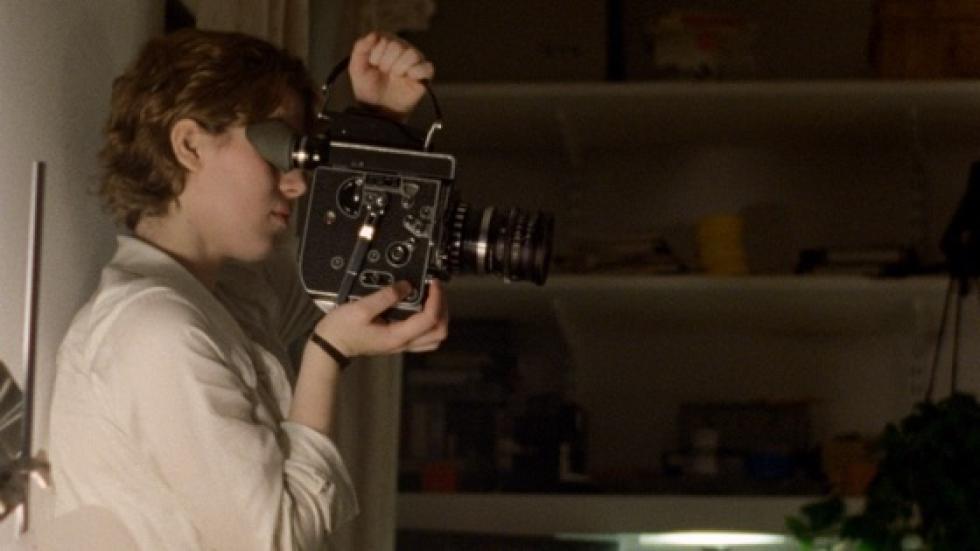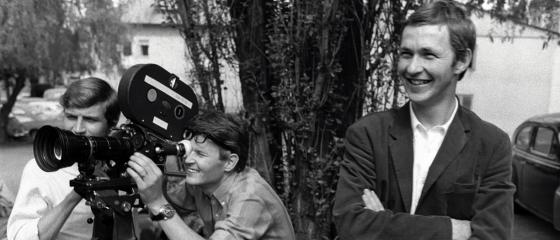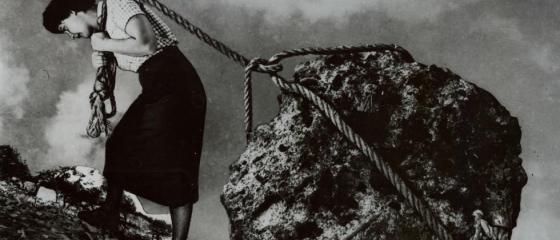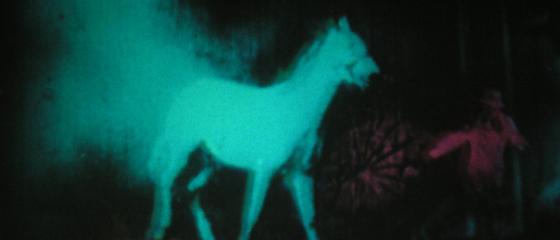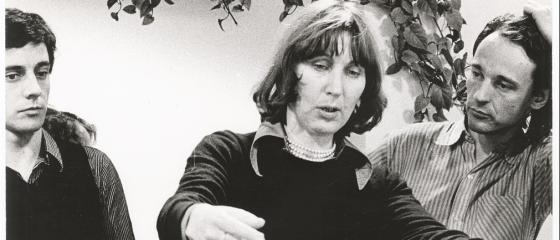At what age does a woman feel confident enough to express herself with an artistic voice of her own? Joanna Hogg (London, 1960) graduated from the British National School of Film and Television in 1986 with the short film Caprice, starring a then-unknown Tilda Swinton. Her first feature film UNRELATED dates from 2007. Throughout the more than twenty years that have passed between her graduation and her film debut, Hogg was not inactive, nor did she devote herself to other tasks. Her career developed over a long period of time in the world of video clips and television. She first worked at Limelight, the production company that produced classic pieces such as A-Ha's Take on Me, and therefore one of the main promoters of the videoclip format as it was commercially institutionalised in the 1980s. There she signed pieces for artists such as Johnny Thunders or Alison Moyet. She was also in charge of directing all kinds of episodes of series as popular in his country as EastEnders or the medical serial Casualty before television fiction acquired its current artistic status. As she has stated on more than one occasion, when she finally decided to shoot her first feature film, it was clear to her that she would do so from an aesthetic freedom at the antipodes of the routines and impositions of television audio-visual production.
In THE SOUVENIR, her fourth feature film and the film that has finally given her the international impact her work deserves, Joanna Hogg partly answers that initial question. Although her first three films already contained certain personal concerns, in The Souvenir she carries out for the first time an autobiographical drama that recalls a tragic love story from her youth, from the time when she was studying at the film school. In the first solo conversation between Julie (Honor Swinton Byrne) and who will become her lover, Anthony (Tom Burke), they discuss film aesthetics. He believes that films should not show life as it is but convey to us how the characters experience it through, in the expression of William Burroughs, his "soft machine", while Julie defends the interest in "authentic" characters and stories. THE SOUVENIR begins with black and white photographs, taken by Hogg herself in those years, about which the protagonist explains her first film project, The Mother, about a boy dependent on his mother in the decadent and working-class context of Sunderland. Julie's images and approach connect with a tradition of social realism that has been identified with British cinema for decades but has little to do with the experience of a young woman who has grown up in a well-off family. As Anthony ends while drinking champagne, Powell and Pressburger's cinema is true without the need to be real. However, and partly due to a certain (bad) class consciousness, Julie wants to make a film that conveys the same kind of emotion and commitment as Elvis Costello's Shipbuilding achieves, as sung by Robert Wyatt. The story of Julie's toxic relationship with this man - both fascinating and destructive, who hides her drug addiction from her- takes place in parallel to the protagonist's learning process at the Film School, where she begins to shoot her first short film marked by aesthetic uncertainties and personal insecurities, before feeling ready to jump into the outside world.

Self-portrait of Joanna Hogg (frame grab from Super 8), 1980 ©Joanna Hogg
When, at the age of 45, Joanna Hogg finally found herself confident enough to make her first feature film from a personal perspective, the film tradition with which she connects will not be that of typically British realism; but neither will the exuberance of Powell & Pressburger's cinema or the technicolour musicals that inspired her short Caprice. In Unrelated and the rest of her filmography, the director links with an expression of cinematographic modernity more typical of France or Italy than of Great Britain; closer to Éric Rohmer, Michelangelo Antonioni or Yasujiro Ozu than to Free Cinema or Ken Loach - although her sharp portraits of family intimacy and open work to improvisation with performers do connect her in part with Mike Leigh's work. Her first two films, above all, are based on an awareness of one's own class that involves scrutinising the internal dynamics of two family groups from a certain distance. Hogg does not fall into that aseptic and surgical aesthetic of one who observes his characters from a certain moral superiority or from an eagerness to avoid self-criticism. On the contrary, her cinema reveals the imbalances of a social environment that she knows well without falling into the easy sentence. The director also avoids the traditional dramatic construction in order to create a staging in which the shots breathe without feeling the obligation of being at the service of a plot. From UNRELATED to THE SOUVENIR, the editing of Joanna Hogg's films, always signed by Helle Le Fevre, reinforces this subtle, mysterious and, at the same time, expressive conception of cinematic narrative.
UNRELATED a priori could be situated in that long tradition of a British cinema in which the protagonists feel repressed desires or feelings blooming in the context of a sensual and open Italy. However, Joanna Hogg already reveals in her debut feature how she distances herself in part from these conventions in order to film the process of reunion with herself of a woman who, in the character's own words, feels "on the periphery of things". The start shows the protagonist, Anna (Kathryn Worth, who by no chance bears an undeniable resemblance to Marie Rivière from the rohmerian Le rayon vert), arriving alone and at nightfall at the home of her friends, a large family group that has invited her to spend the holidays with them. Anna is soon more attracted to the overflowing energy and carelessness of young people than to the routines of adults of her own age.
Hogg presents a protagonist still unusual in contemporary cinema at the time, a forty-something woman without children who suffers the dislocation of her situation: she does not connect with the inertia of other adults, it is assumed that she is no longer old enough for young people's parties. Anna has temporarily left behind her partner Alex in London. Here she is attracted to the young Thomas (a debutant Tom Hiddleston), with whom she seems to share a certain sexual chemistry. Unrelated shows how this woman tries to live this process of re-connection with her sensuality in a moment of crisis and in an environment that a priori invites her to it. However, her displaced condition partly frustrates this desire.
Although UNRELATED is located in a beautiful mansion near Siena and the characters talk about the festivity known as Palio, Hogg avoids another of the tropes of these films, the concrete interaction with some element of the local culture that acts as a catalyst for the emotions of the protagonist. Choreography, on the other hand, is a precise exercise in observing the distances between the protagonist and this family group, whose internal dynamics never quite fit in. The tension that Anna occupies within the painting functions both as a centripetal and centrifugal force with the rest of the characters. When she is most displaced, it is precisely in the rituals of arrival and farewell to the residence, those that mark the continuity of belonging to a relational nucleus.
Irony and reflection
As Unrelated does, ARCHIPELAGO focuses on a family, in this case smaller and composed of Edward (Hiddleston, again), his sister Cynthia (Lydia Leonard) and mother Patricia (Kate Fahy), vacationing in a place far from their home in one of the islands of arid and windy beauty of Sorlingas Archipelago, off the coast of Cornwall. There is also a woman outside the group, the cook Rose (Amy Lloyd), who gravitates around her and flirts with the character of Tom Hiddleston, although here she is not the protagonist. Also, an absent husband with whom you only talk on the phone. Archipelago is so far the only Hogg film that doesn't focus on a specific female character, and instead delves into the discontent of the members of this well-to-do family who spend a few last days together before the brother leaves for a season of humanitarian mission to Africa. The two brothers in their thirties experience personal crises that will express themselves in a complementary way linked to their social condition.
In the most uncomfortable sequence of the film, Cynthia stars in one of those moments of a priori anecdotal but evident abuse of class privileges with respect to the workers of the restaurant where all the characters have come to eat. In a previous sequence, Edward wanted to invite Rose to sit at the family table, which provokes an argument with his sister. If Edward wants to hide the class distance so as not to feel guilty, Cynthia underlines it instead. In both cases, the conflict generates a disruption not so much in Rose or the restaurant workers as, above all, within the family group itself. Hogg adds other scenes in which he cracks the appearances of the beautiful films of rich people on vacation, such as when it is detailed the cruel process of turning lobsters or pheasants bought directly from their producers into delicious delicacies.
ARCHIPELAGO begins with a secondary character painting an oil canvas outdoors. The first appearance of the protagonists in their holiday home takes place in a room presided over by the stain that indicates the absence of a painting just above the home. In his second feature film, Hogg makes the pictorial quality of his images more explicit and incorporates a greater degree of self-reflection, not without irony, around the way of understanding art. Her painter character is dedicated to landscapes but, as it is customary in the British filmography, the outdoor framing of the film avoids mere preciousness to underline, instead, that arid aspect of the environment. However, it is above all interior painting that interests Hogg, who here notes the always obvious weight of Chantal Akerman's cinema, but also the influence of Vilhelm Hammershøi's work on the framing of these women with their backs in crisis with the idea of home.
The feminine body in the public space
Along her progressive move towards a cinema of intimacy, this third feature EXHIBITION witnesses how Hogg leaves the family and holiday context to focus for the first time on the home life of a couple, middle-aged artists without children (a situation similar to hers) who are about to sell the house where they have resided in recent years. Traditionally, in films that turn the house into the refuge of a happy time or into the shelter of family memory, the home in question responds to the traditional architectural lines of the bourgeois house, as it was understood until the beginning of the 20th century. When a family resides in an apartment designed in the modern style, this usually entails some kind of connotation linked to the socio-economic status of the protagonists but also to the tone of the film. Rationalist traditional architecture is associated with emotional coldness or existential alienation, the setting of a criminal thriller or a Michael Haneke-style drama. Hogg also distances herself here from this commonplace. In EXHIBITION, the sale of the beautiful house designed by the British architect James Melvin, for reasons we never get to know, is a symptom of some kind of crisis within the couple. The building speaks, of course, of the social class of the protagonists, an architect H (conceptual artist Liam Gillick) and a performer D (Viv Albertine, pioneer of female postpunk with The Slits). However, there are here some warm ties, touching the erotic, that the couple, and especially D, has formed with those walls that must be abandoned.
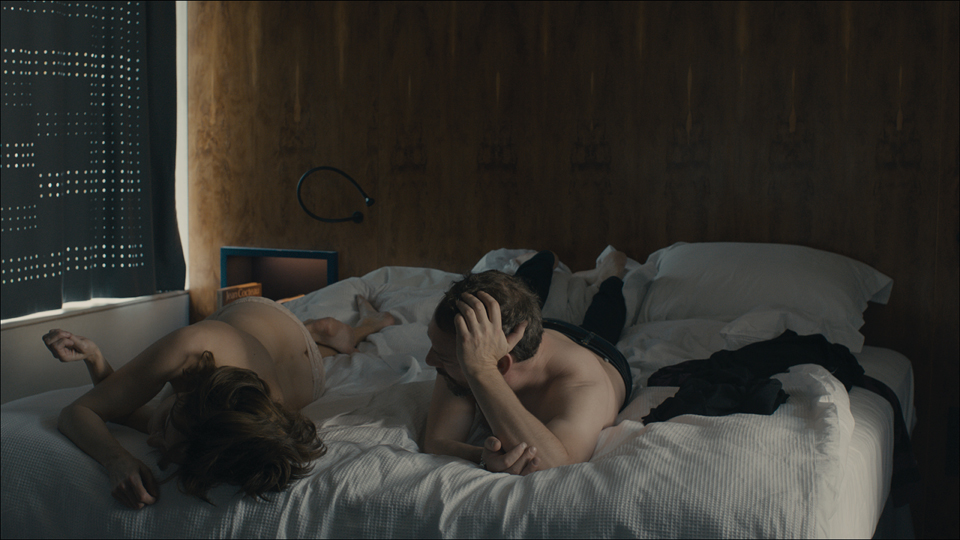
EXHIBITION thus reveals the extent to which non-experimental cinema has been incapable of articulating a relationship with contemporary art as a theme, experience and context that would overcome the simplistic and sceptical clichés of a century ago. D's profession and the design of the house with its typical glass walls allow Hogg to combine two of the shaping concerns of feminist cinema - the self-representation of the figure itself and the relationship established by a woman with the spatial-temporal dimension of the home. The reflection raised by the first performance artists on the vulnerability of the female body exposed in public space as an artistic work expands here to a house whose design partly blurs the boundaries between private, public and intimate.
"On the first day of filming I am fully aware of my age. Films in which there is a camera so close to the face of an older woman are rare”,Viv Albertine writes in the chapter of her memoirs Clothes Music Boys - dedicated to the filming of EXHIBITION - where she explains that Hogg asked her to work without make-up and suggested that she review the film by Chantyal Akerman, Jeanne Dielman, 23 quai du Commerce, 1080 Bruxelles, for inspiration. D. works on his artistic projects with the same daily naturalness with which Jeanne peels potatoes. But if Akerman films his protagonist from a cadence that reveals the alienating dimension of his domestic life, Hogg instead shows a woman who has turned her work also into a way of reconnecting with the intimacy of her body, and maintains a much warmer bond with the home, which manifests itself through body contact. As in the rest of her films, Joanna Hogg also follows the protagonist's inner path here until she finally manages to close a period of crisis in her life and move on.



